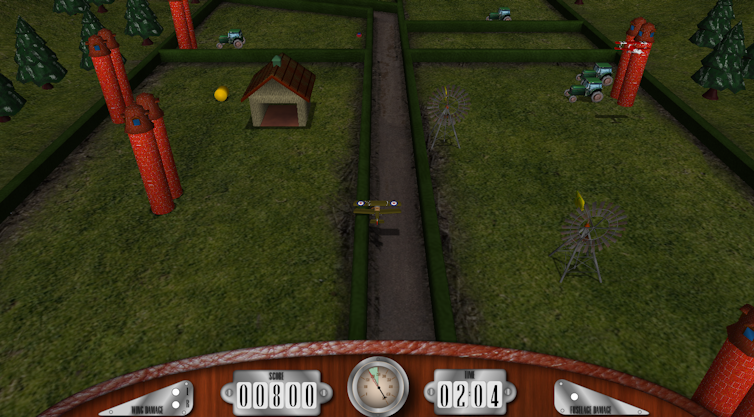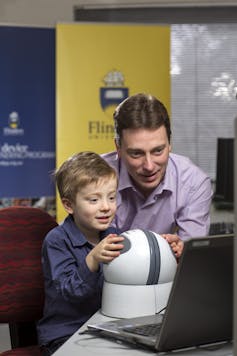The condition results when there is an injury to the developing brain that goes on to affect a child’s movement and posture, but can also include the senses (vision, hearing, touch) and cognition (thinking). On average, the incidence of CP means that a new case occurs every 500 live births, or approximately once every 18 hours. There is no cure for CP and it is a life-long condition.
Most children with CP require ongoing therapy and exercise to maintain or improve their function. Typical therapy programs target the legs, meaning the child can be independently mobile, and the hands and arms, so the child can be independent with activities of daily living, like dressing, feeding and manipulating objects.
These exercises are necessary to improve muscle and limb coordination, control and range of motion. However, engaging children with CP in meaningful therapy can be difficult, despite the merits of the exercise and the potential therapeutic benefits. Like most exercises, they are seen as work.
My interest in this area, and the subject of my doctoral studies, relates to how children with CP use their hands. Most children with CP typically have a dominant hand, the one they use all the time for all activities, and a non-dominant hand. The non-dominant hand is the target for most therapy, as improving the function of that particular hand should lead to greater independence for the child overall.
It’s also generally acknowledged that children with CP are less sensitive to tactile cues. That is, they are less sensitive to touch, find it difficult to know where their hand is in space – called proprioception – and have difficulty manipulating and identifying objects in their hands through touch alone.
I wondered if it was possible to improve hand sensation and function through an activity that would require a child with CP to actively use and focus their attention on both their hands. To do this, I needed a highly engaging yet accessible activity. Like gaming.
Serious games
These days, most of us have at least one gaming console at home, be it a Microsoft Xbox or Sony PlayStation. However, we probably play it for fun.
But what if gaming could have a different purpose? What if it wasn’t about high scores but more about participation? What if we could game to improve our health and physical ability?

Welcome to the world of “serious games”: games for which the primary purpose is not pure entertainment. One sub-category is health gaming – also called “exer-games” – which are made specifically to improve physical ability and health.
According to research, serious games have been used with children with CP since the late 1990s and have been shown to increase motivation.
None of these previously reported studies attempted to actually improve tactile sensation, though. Instead they focused on motor function. So that became the focus for my PhD, because there is evidence that adequate motor and sensory function is required for good functional outcomes. I elected to design and trial a gaming system to improve hand sensation and function for children with CP.
I led a team that developed what we called the “OrbIT” gaming system. This is a custom designed, home-based, accessible gaming system for children with limited hand function.
The system comes in two parts: a laptop that runs all the custom-made computer games, and a spherical or orb-shaped controller that promotes accessibility, and is how the child interacts with each game.
One of the games requires the player to guide a squirrel up a never-ending tree to collect acorns and coins while avoiding tree branches. Another requires the player to fly their 1922 biplane through the countryside while avoiding barns, windmills, silos and other aircraft.
The controller is easy to manipulate and doesn’t require fine finger control. It has smart-sensors built into it that monitor hand position on the device, and vibrates in response to various game activities.
If the child removes their hands from the smart-sensors during game play, the system pauses, requiring them to re-position their hands on the controller if they want to continue playing. We’ve found this to be a very powerful way to ensure that both hands are always engaged with the controller, which is a requirement for therapy.
We trialled OrbIT with a number of children with CP and their families for six weeks in Adelaide.
A common theme was that OrbIT improved social interaction amongst siblings, presumably because it was the first gaming system that provided an equal playing field. Due to the design, children with and without hand impairment could play OrbIT, and children with CP didn’t have to worry about poor performance caused by their limited hand function.

Most children loved having OrbIT at home and didn’t want to return it at the end of the trial. Parents made some encouraging observations following the experience: one child talked more during the trial as he would talk game strategy with his sister to improve her game play. Another child began to talk to visitors about disability and “his CP” when they saw OrbIT on the dining room table as it became a talking point. Another parent noted that her son learnt considerable hand control through using the controller.
From a research perspective, our study was underpowered in terms of detecting a change in tactile sensation, meaning we need to conduct a larger trial before a definitive conclusion can be drawn. However, our research identified a positive outcome following analysis. Overall, the children’s non-dominant hands performed better during tests of manual manipulation and hand function after the trial compared to before the trial started.
Gaming is being used for many different applications and the upside is bright, particularly if accessibility is considered. When combined with augmented reality, we see examples of amazing uptake (think of the mass appeal of Pokemon Go).
As technology improves and smart devices become ubiquitous, so will gaming, but not just because players want to get a high score. People will be gaming for their health, well-being and personal development.
